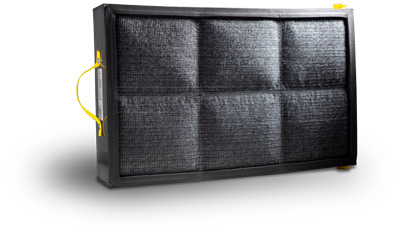
Activated carbon is used in a wide variety of purification techniques including air filtration, pharmaceutical manufacturing and water purification. Activated carbon exists in several physical forms, including powdered, bead and extruded, however granular activated carbon is one of the most commonly used for air filtration, particularly in activated carbon filters in laboratory fume hoods. Granular activated carbon has a much larger particle size with a small external surface, which increases its diffusion rate and makes it the carbon of choice for vapor adsorption. The huge surface area of activated charcoal provides countless bonding sites, but once all of the bonding sites are filled, an activated charcoal filter stops working. At that point, the filter must be replaced.
Activated carbon filters are constructed in two main styles granular multi-layer free fill and bonded filters, each of which serves different purposes in the containment industry.
Granular multi-layer free fill carbon filters contain loose fill carbon media layered to meet specific chemical filtration needs. Granular carbon media is filled into a solid filter frame which allows minimal media settling for optimal airflow through the loose carbon fill. Granular activated carbon filters can contain carbon impregnated for a single target analyte or can be layered with carbon impregnated for a number of analytes, increasing the range of containment. Granular loose-fill filters generally have a longer life span and are lighter weight than bonded filters. Granular filtration maintains the original physical and chemical properties of the carbon and offers the greatest amount of surface area for chemical bonding sites.
Bonded carbon filters utilize the same granulated carbon as loose-fill carbon filters, but use various chemical processes to bond the carbon together into a solid matrix, creating a rigid carbon filtration system often selected for convenience of handling as they are considered to be more manageable than granular loose-fill filters. Bonded filter manufacturers claim that due to the solid nature of the filter, there is less chance of user exposure to the chemicals contained within a used filter. Bonded filters are also typically claimed to be “dust-free” because the carbon particles are bonded together in a solid form. It is possible, however, that as a result of the brittleness of the bonded filter, that partial filter erosion may take place in shipping and allow fine particles to be exhausted during initial fume hood start-up following a filter change.
Bonded vs Granular Free Fill Carbon Filters
Bonded carbon filters are widely marketed as having equal if not better efficacy than loose fill granulated carbon filters, as manufacturers claim that a solid filter matrix minimizes dead zones in the filters and maximizes capacity. Others in the industry have questioned the effect that a solid matrix has on filter performance.
Regardless of the proprietary bonding process, to create a solid matrix from loose granulated carbon, the physical and chemical properties of the carbon particles must be altered. Bonded manufacturing causes some of the carbon pores to be crushed or destroyed, which decreases the adsorption capabilities. The bonding process typically requires the activated carbon be soaked in water for approximately 24 hours prior to being bonded. This soaking can leach out the impregnated chemicals required to effectively manage certain types or vapors, decreasing the efficacy of the final filter. As a result, bonded filters are typically only offered with a single type of impregnation, which can limit the use of the fume hood in which bonded filters are installed and increase the expense of maintaining compliance for certain laboratory operating procedures. The bonding agents used to create bonded carbon filters are normally a type of resin such as polystyrene. The amount of resin used has a critical impact on the adsorption capacity of the filter and can result in a significant amount of the carbon granules covered with this bonding agent. This renders the filtering capacity of the carbon granules reduced, at least temporarily, may have long term effects on filter efficiency.
These disadvantages of bonded carbon filters can lead to additional negative effects, including a noticeable pressure drop in the fume hood and less efficient air filtering capabilities over the life of the filter. These alterations likely have detrimental effects on the ability of the carbon particles to bond with target compounds and could also decrease flow rate of a bonded filter compared to a loose carbon filter. Bonded carbon filters also tend to weigh more than granular filters which can make filter change out more difficult, while their brittle nature can lead to quality issues in the shipping and handling process.
An independent study undertaken to compare granular activated free fill filters to bonded filters revealed that the granular activated free fill carbon filter, specifically the Air Science® filter using the Multiplex™ Filtration System, has a longer useful life and greater filtering efficiency with no associated performance deficit than a dimensionally identical bonded carbon filter. The study indicated that under similar laboratory conditions, granular free fill carbon filters maintain safe operating conditions for a longer period of time than bonded carbon filters. The Air Science filter exhibited greater than a 25% adsorption efficiency than the comparable bonded filter, taking 95 minutes longer to reach 1% TLV saturation, suggesting a significantly longer useful life than that of the bonded filter. Granular loose fill filters also have additional performance benefits in the form of ease of handling, greater stability in shipping and packaging, and fewer chemical impregnation issues compared to bonded filters and can be configured to meet specific filtration needs.
The results of this study verify that under similar laboratory conditions, Air Science granular carbon filters have a greater filtering efficiency and will maintain safe operating conditions for a longer time period than similarly-sized bonded filters. Air Science granular carbon filters have none of the issues associated with bonded filters and provide a higher retention capability over the useful life of the filters. This decreases the frequency and associated downtime and expense of filter change outs.

The Air Science Multiplex Filtration System, which consists of a pre-filter, main filter and optional safety filter creates a combination of chemical and physical architecture customized to each application. The multiplex option permits one or more filtration types to be combined within a single filter housing to meet a wider range of multiple-use applications. Multiplexing allows for the capture of acids, bases and when paired with HEPA or ULPA filters, particulates such as biological aerosols. An additional benefit of the Air Science granular carbon filter is fire suppression. Granular carbon filters used in enclosure fire tests resisted ignition and helped suppress the fire. It is suspected that under similar test conditions, bonded filters would display some ignition due to the various chemical resins used to bond the carbon particulates together.
The Air Science granular free fill carbon filter outperforms bonded carbon filters in nearly every way. Air Science granular carbon filters are self-contained assemblies, sized to fit the specified product model number and configured to optimize air flow across 100% of the filter surface area for maximum efficiency, prolonged filter life, optimal diffusion and saturation capacity and enhanced user safety.
 Did You Know?
Did You Know?
Aftermarket, homemade, or other filters purchased from unauthorized sellers pose significant risks for employees. While these filters can seem like a cost savings, they are often homemade using materials that will not protect against VOCs and other hazards generated on the work surface.
Learn more about the importance of high quality filter replacements with our Free Filter Integrity Ebook.